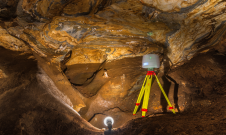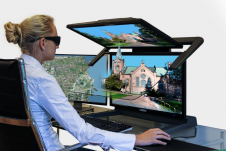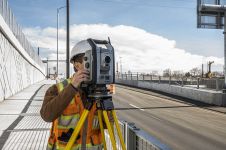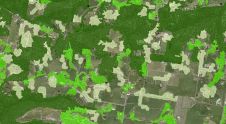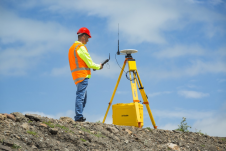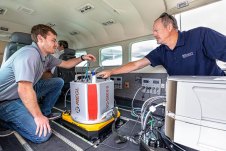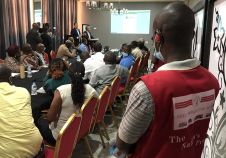Pictometry: Long-term Impact on GI Market
GIM Interviews Arne Saugstad and Nils A. Karbø, Blom Group
In September 2005 Blom Group consolidated its already firm position on the Geographical Information (GI) market within Europe by entering into an exclusive licencing agreement with US-based Pictometry for 23 European countries. Pictometry is a new technology for the collection and processing of oblique and vertical aerial photographs. Within a rapidly evolving GI market, the interviewees have a strong ambition to play a major role in driving change.
What is your mission and what are your main products and services?
Our business model is the collecting, processing and selling of high-quality GI. The demand for advanced, flexible GIS is growing rapidly and our ambition is to be the most innovative and preferred provider of GI in Europe. We want to take a greater share of the information-technology value chain through increasing value-added solutions based on our offered geographical databases. Our products and services relate to this ambition: aerial photography and photogrammetry, laser scanning (Lidar), Digital Elevation/Terrain Models (DEM/DTM), and mapping and modelling. Further, we provide geographical databases such as Pictometry, TerraItaly and other national and local libraries, and database applications such as 3D-city models, forestry and location-based services.
How big is the company in terms of number of employees, equipment and turnover, and who do you consider your main (inter)national competitors?
我们的营业额在2006年将大约100毫升lion euros and we have a thousand highly skilled employees in eleven countries. We operate 33 aeroplanes and four helicopters. The fleet is distributed around Europe and able to serve the whole continent with digital aerial photography for vertical and oblique images, Lidar and multi-spectral scanning. On a European scale we do not see any real competitors, but there are several regional and local competitors in each of our respective markets.
Who are your main clients and how is your customer-base distributed over the continents?
Today our main clients are municipalities, national mapping agencies, other government or public agencies and consultancy companies. We are experiencing strong growth in the private sector, where there is an increasing demand for GI products; one example are online map-service companies. Microsoft is an example of a large and important customer from the private sector. Our main and home market is Europe, where most of our revenues are generated. We are leading in Italy, UK, Spain and most Nordic countries. Germany is a market in which we are small relative to opportunities, and we want to expand there. Romania is an example of a country that is becoming more important, having become a member of the EU. We are also successfully engaged in projects across the world on a case-by-case basis.
Could you briefly describe three major projects carried out recently?
First of all, the Pictometry project. We are currently undertaking one of the largest image-acquisition projects in Europe, involving eleven aircraft and oblique camera systems to create a standard database of oblique and vertical imagery covering every town in Europe with a population larger than 50,000 inhabitants, a total of approximately nine hundred towns. The project involves major logistics in terms of aircraft movement around Europe and ensuring their optimal operation in the face of weather, air-traffic control and security issues. Furthermore, considerable data management is required to ensure that five million images are effectively processed, backed up, stored and disseminated. We have developed a geo-database to manage this and to provide the data via online solutions. Libraries are currently available for most countries and we are well ahead of schedule to complete this project by 2007. Then we will start updating on the basis of a two-yearly cycle, and adding towns, depending on market demands. All images are geo-referenced and suited for integration with geographic data, either via dedicated software or using plug-ins with commercial GIS software. Secondly, there is the Lidar and digital aerial-photo project for Indre Storfjorden in Norway, executed between October 2005 and July 2006. Around 600km2 of mountainous fjord areas were captured for landslide modelling and for use in tsunami warning systems. Further, we have recently carried out many Lidar projects within Europe. A third project is taking place in Cameroon, Africa, carried out for the Ministry of Economy and Finance through the National Commission of Fiscal Cadastre and financed by the Spanish Fund for Development. This project, worth 32 million euros, consists of the Development of Urban Cadastre in the main 57 cities, covering in total 279,000 km2 and a million real-estate properties.
What do you see as the main advantages of Pictometry technology over traditional photogrammetry and Lidar?
Pictometry is complementary to traditional photogrammetry and Lidar and cannot replace photogrammetry for accurate mapping nor replace Lidar for dense DEM/DTM extraction. It is a patented technology that allows users to easily and efficiently view and observe any point chosen from five angles (Nadir, North, West, South and East). This allows them to enhance the visual appearance of models created fromphotogrammetryor Lidar, showing only the ground and top of structures. Because Pictometry shows previously hidden parts of buildings and other structures the technology enables creation of a much richer database of the real world. It can be viewed in existing GIS or included software with standard features such as zoom, pan, measure (height, distance, area and altitude) and walk-about, which selects the best bordering image as required. The number of storeys and height of buildings can easily be determined. Such information on building structures and facades, combined with DTM information, is useful for existent cadastral applications, for determining property taxes and providing building permits. Lidar can be a very good supplement to pictometry as it gives very accurate DEM/DTMs, allowing highly automatic 3D creation.
What market do you expect for Pictometry, both in terms of public/private segments and regions?
这项技术为专业人士和非是有用的-professionals because facades of buildings become visible, giving a different visualisation experience than that offered by traditional orthophotos. Accordingly, the market is very varied and ranges from municipalities to media and from blue lights to telecom. Customers appreciate that they are buying a standardised, up-to-date product that has the same features across the country and across Europe. The plug-ins to major GIS packages also offer comfort. Microsoft is a major pan-European customer and a partner of ours; it has purchased a European licence for Pictometry. The possibilities of the technology will reach millions of people in Europe and open up a big potential market, which is, we think, spread fairly evenly across Europe…
So geo-information for the millions…
… indeed! GI is becoming more and more available to the public through increased data coverage and better web access. This opens up new opportunities for players within the GI market. As a pan-European company we have the ability to play a major role in this market. We are now working on many exciting projects, such as creating new and innovative products based on Pictometry: Location Based Services allowing Pictometry viewing on a mobile telephone, and 3D-models which integrate Pictometry in a highly automated fashion. Such projects were unthinkable for us just a few years ago but are now a reality thanks to the convergence of technology, customer demands and the size of Blom, which is critical.
你与大学和研究我合作吗nstitutes to improve and innovate in terms of your products - please elaborate?
Our subsidiaries co-operate with universities and research institutes. It is important for us to keep in touch with research and development to update our products and services. But we are not a research institute and we will always seek partners with that philosophy when developing new products and technology. Improvements and innovation in our products come about mostly as a result of demands from our customers and the market.
你如何看待你的角色作为地理信息收集器nd provider within the context of poverty reduction in developing countries?
Our role is to support work towards building infrastructure in developing countries and those in transition. GI enjoys important political value since it makes possible the integration and formulation of national policies, legislation and programme planning, and their follow-up and evaluation. GI is necessary in many sectors such as the environment, resource management, physical infrastructure, agriculture, property registers and health. We have wide experience in supporting governments and/or Non-Governmental Organisations (NGOs) all over the world in cadastral work, resource mapping, topographic mapping and aerial photography. It is important to use proven technology, defined standards and emphasise knowledge transfer to support the sustainability of such projects.
What are your expectations for the future?
Technologies are converging; markets and customer demands are in transition. Governments are changing from creating and providing GI to licensing existing libraries at better quality and lower cost. The GI market is going through a time of rapid change and we believe it is important to play a role in driving this.u
Company Background
Blom ASA, established in 1954 by Hydrographer Ole H. Blom, was listed in 1988 on the Oslo Stock Exchange. The company has always been a leading provider within the mapping industry and is now a healthy pan-European company leading in the field of collecting, processing and delivering GI. After a major reorganisation and restructuring in 2003, Blom acquired several mapping companies across Europe. Today Blom Group comprises two divisions:
Geographic Information and Offshore Technologies. Acquired companies now incorporated within the Geographic Division of Blom Group include BlomNorkart mapping (Norway), Fotonor (Norway), FM Kartta OY (Finland), Geo-Tec GmbH (Germany), Geonet SRL (Romania), Simmons Aerofilms Ltd (UK), TopEye AB (Sweden), Compagnia Generale Ripreseaeree (Italy) and Seficart Group (Spain).
Make your inbox more interesting.Add some geo.
Keep abreast of news, developments and technological advancement in the geomatics industry.
Sign up for free













